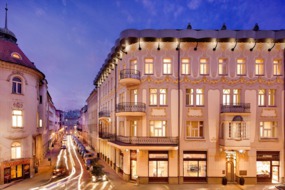
27-28 October
Setting sail from Budapest
Budapest is one of Eastern Europe's most appealing cities, a vibrant and welcoming capital that straddles the Danube. The history of Budapest has been somewhat turbulent - ransacked by the Mongols in 1241, occupied by the Ottoman Turks for over a century, and almost flattened by the Soviets in 1945 - but plenty of older buildings survive, including the imposing Parliament and iconic St Stephen's Basilica. Although a pedant might point out that Budapest has only really existed since 1873; up until then the city's two distinct halves, Buda and Pest, were separate towns.


Don't miss
If you are a music lover, you can’t miss a performance at the Opera House – affordable, and great music in a wonderful building.
28 October
Hungary: Mohács

Mohács was the scene of a decisive battle in 1526 that brought Hungary under Ottoman control, but is best known these days for its Busó carnival in February, when men in creepy-looking costumes take to the streets to celebrate the end of winter. The town is also a jumping off point for the attractive city of Pécs, half an hour’s drive away.
29 October
Croatia: Vukovar

Vukovar is one of the great tragedies of the Balkan wars, a once prosperous and elegant city reduced to rubble by fierce fighting between Croats and Serbs. There are green shoots of optimism as the city rebuilds, but the battle-scarred streets are a powerful reminder of the devastating conflicts of the 1990s.
30 October
Serbia: Belgrade

Belgrade has been invaded and occupied dozens of times over the centuries, a fact that's reflected in the mish-mash of architectural styles, from Ottoman and Art Nouveau to grim relics of the communist era. But Belgrade is also a city with real soul, emerging from a difficult recent history as one of Europe’s most exciting capitals.
31 October
Romania: Iron Gates

As the Danube wends its way east, along the border between Serbia and Romania, the river narrows to a dramatic gorge known as the Iron Gates. The river here is flanked by a huge stone carving of Decebalus, the last king of the Dacians and a Romanian national hero.
1 November
Bulgaria: Vidin

The riverside town of Vidin is situated in the north west corner of Bulgaria, close to the border with Romania and Serbia. The architectural highlight is the magnificently well preserved Baba Vida fortress, and the town is also home to a mosque, a synagogue and several churches.
2 November
Bulgaria: Ruse

The Bulgarian city of Ruse (also written ‘Rousse’) sits on the right bank of the Danube just opposite the Romanian city of Giurgiu, and is one of the country’s most attractive cities. Sometimes known as ‘Little Vienna’, thanks to the plethora of Neo-Baroque and Neo-Rococo architecture, it’s a highlight of any cruise along this stretch of the Danube.
3 November
Arriving in Giurgiu
The river port of Giurgiu is situated just across the Danube from the Bulgarian city of Ruse, and the two cities are linked by a cross-border Friendship Bridge. You're unlikely to spend much time in Giurgiu itself, but the port is the start and end point for river cruises on the lower Danube, and is linked by road and rail to Romania's capital, Bucharest.

Your home from home



What we love
AmaBella and AmaVerde offer the perfect home from home for 161 guests, with two lounges and two dining options, including the intimate Chef's Table where you can watch the chef prepare your gastronomic delights.
| Capacity | 161 Guests |
|---|---|
| Crew | 49 European Staff |
| Style | Relaxed and informal during the day, giving way to an elegant evening atmosphere. |
| Inclusions |
|
| Year Built | AmaBella 2010, AmaVerde 2011 |
| Length | 443 feet |
| Breadth | 38 feet |
Tailor-make your trip

Our favourite hotel in Budapest
We like the Hotel Palazzo Zichy on the Pest side of the river, which used to be the residence of Count Nándor Zichy.

A taste of Hungary
If you’re a wine lover, you really should visit the world’s oldest classified wine region, known for its sweet Tokaji aszú dessert wine.










